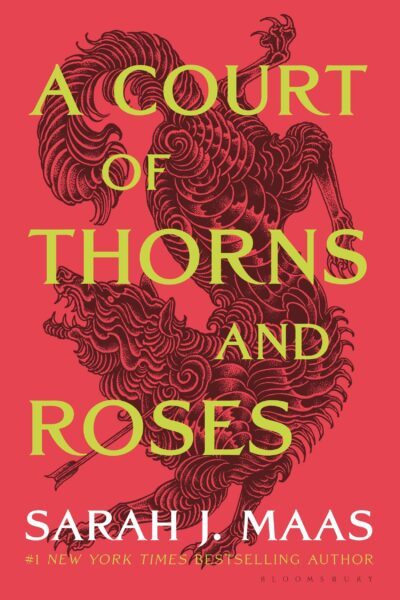
A Court of Thorns and Roses
Chapter 42
by Maas, Sarah J.The chapter opens with Feyre attending a lavish faerie party, acutely aware it may be her last night alive. Despite the revelry around her, she feels isolated, marked by her painted skin and the weight of her impending fate. She observes Rhysand, her captor, indulging with another faerie, while avoiding Amarantha’s presence. Feyre’s detachment is palpable as she waits for Rhysand’s command, her thoughts consumed by the trials she faces the next day. The festive atmosphere contrasts sharply with her inner turmoil, highlighting her resignation and dread.
Feyre’s solitude is interrupted when Tamlin unexpectedly approaches her, their brief, charged interaction reigniting her emotions. Their hands brush, sparking a fleeting moment of connection amidst the chaos. Tamlin’s subtle gesture leads Feyre to follow him to a hidden door, where they steal a private moment. The tension between them erupts into a passionate, desperate encounter, driven by the knowledge that this could be their last chance to be together. Their physical intimacy is raw and urgent, a stark contrast to the cold, controlled facade Feyre maintains in public.
Their reunion is abruptly shattered when Rhysand appears, mocking and threatening them. He leverages Amarantha’s potential wrath to force Tamlin’s compliance, emphasizing the danger of their relationship. Tamlin reluctantly obeys, leaving Feyre behind after a heartfelt but hurried declaration of love. Rhysand’s taunts and power play underscore the oppressive dynamics of their world, where even moments of genuine connection are fraught with peril. Feyre’s defiance flares, but she is left vulnerable and exposed, both physically and emotionally.
The chapter ends with Rhysand confronting Feyre, his anger and dominance on full display. He pins her against the wall, accusing her of recklessness and reminding her of her precarious position. Their exchange is tense, with Feyre resisting his control despite the overwhelming odds. The confrontation leaves her grappling with the consequences of her actions and the harsh realities of her enslavement. The chapter masterfully blends emotional intensity with the ever-present threat of violence, setting the stage for the climactic trials to come.
FAQs
1. How does the protagonist’s emotional state contrast with the festive atmosphere of the party?
Answer:
The protagonist (Feyre) experiences deep emotional turmoil despite the lively party atmosphere. While faeries “drank and lounged and danced” with carefree abandon, Feyre remains acutely aware that this might be her last night alive, stating “Perhaps they knew I would die, too.” Her sunset pink gown feels incongruously “too cheery” against her grim reality. This stark contrast heightens the tension, emphasizing her isolation and the weight of her impending trial. The revelry around her seems almost cruel in its normalcy, as no one acknowledges the life-altering event she faces tomorrow.2. Analyze the significance of Tamlin and Feyre’s clandestine meeting. What does this reveal about their relationship under Amarantha’s rule?
Answer:
Their secret encounter reveals both the depth of their connection and the extreme danger of their circumstances. The rushed, passionate interaction (“I couldn’t kiss him deeply enough”) shows their relationship has become one of stolen moments rather than open affection. Tamlin’s whispered “I love you” carries profound weight as it may be their final exchange. The scene also demonstrates Amarantha’s oppressive control - they must hide even basic physical contact, and Rhysand’s intervention shows how closely they’re monitored. Their desperation reflects how the political situation has forced their love into brief, intense bursts of connection.3. How does Rhysand’s behavior in this chapter create ambiguity about his true motives?
Answer:
Rhysand displays contradictory behavior that complicates his allegiance. While he interrupts Feyre and Tamlin with threatening language (“Amarantha would be greatly aggrieved”), his actions suggest possible protection. He appears through the walls rather than exposing them publicly, and his warning about Lucien’s potential punishment implies he understands the consequences of their actions. His physical aggression toward Feyre (“pinned my arms to the wall”) contrasts with his earlier tolerance of her presence at parties. This duality leaves readers questioning whether he’s truly aligned with Amarantha or playing a more complex game.4. What symbolic meaning can be derived from the body paint Feyre wears throughout these events?
Answer:
The “blue-black paint” tattooed on Feyre’s body serves as a visual metaphor for her oppressed state. The paint’s unnatural color contrasts with her human identity, marking her as Rhysand’s possession (“my pet”). When Tamlin’s clothes become marked with paint from her body, it physically represents their forbidden connection before Rhysand magically removes it - symbolizing how their relationship must remain hidden. The paint’s permanence throughout her ordeal reflects how deeply the faerie world has changed her, while its removal from Tamlin shows how their bond cannot leave visible traces in this dangerous environment.
Quotes
1. “I lived in that moment—my life became beautiful again for those few seconds when our hands grazed.”
This poignant moment captures Feyre’s fleeting joy amidst her impending doom, highlighting how Tamlin’s touch briefly restores her sense of hope and humanity in the oppressive faerie court.
2. “What I felt was wild and hard and burning, and so he was with me.”
This passionate declaration embodies the intensity of Feyre and Tamlin’s connection, contrasting their raw, desperate love against the cold political machinations surrounding them.
3. “Our tongues danced—not a waltz or a minuet, but a war dance, a death dance of bone drums and screaming fiddles.”
The visceral metaphor reveals how their intimacy has become charged with mortality and defiance, transforming passion into a rebellious act against their grim circumstances.
4. “I love you.”
Tamlin’s simple yet powerful declaration before leaving carries extraordinary weight as it may be their final exchange, underscoring the tragic stakes of their forbidden relationship.
5. “Do you actually intend to put yourself at my mercy, or are you truly that stupid?”
Rhysand’s threatening question marks a pivotal confrontation, revealing both his dangerous power over Feyre and the complex tension between them that foreshadows future developments.
